Improve the photovoltaic performance of new quinoxaline-based conjugated polymers from the view of conjugated length and steric hindrance
Abstract
In this work, we have synthesized two new quinoxaline derivatives: 2,3-bis(n-octylthiomethyl)-5,8-dibromoquinoxaline (QS) and 2,3-bis[(5-octylthio)thiophen-2-yl]-5,8-dibromoquinoxaline (QTS); in addition, three new donor–acceptor (D–A) copolymers: poly{4,8-bis(2-ethylhexyloxy)-benzo[1,2-b:4,5-b′]-dithiophene-alt-2,3-bis(n-octylthiomethyl)quinoxaline} (PBDTQS), poly{4,8-bis(2-ethylhexyloxy)-benzo[1,2-b:4,5-b′]-dithiophene-alt-2,3-bis[(5-octylthio)thiophen-2-yl]quinoxaline} (PBDTQTS), and poly{2,3-bis[(5-octylthio)thiophen-2-yl]quinoxaline-5,8-diyl-alt-thiophene-2,5-diyl} (PTQTS) were designed from the view of extending the length of conjugated side chain and reducing the steric hindrance of building blocks. Replacing the carbon atom in the side chain of polymer PBDTQS with a thiophene ring could increase the conjugation length and improve the absorption in the visible region of the copolymer PBDTQTS and PTQTS. Furthermore, polymer PTQTS exhibited a more planar backbone and increased intermolecular π-stacking compared to PBDTQTS, which was because the thiophene unit in PTQTS had smaller size and less steric hindrance than those of benzo[1,2-b:4,5-b′]-dithiophene unit in PBDTQTS. For the optimized polymer solar cell of PTQTS : PC61BM, PCE of 3.73% with Voc of 0.76 V, Jsc of 9.41 mA cm−2 and FF of 52.33% under an AM 1.5 G solar simulator with an intensity of 100 mW cm−2 was achieved, which was the best performance among the three copolymers. The results implied that the PTQTS with thiophene as the donor unit and QTS as the acceptor unit in the main chain would be a promising donor candidate in the application of polymer solar cells.


 Please wait while we load your content...
Please wait while we load your content...